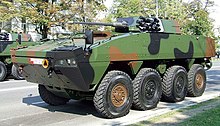Polish armed forces
|
|||

|
|||
| guide | |||
|---|---|---|---|
| Commander in Chief : | Andrzej Duda | ||
| Defense Minister: | Mariusz Błaszczak | ||
| Military Commander: | General Rajmund Andrzejczak | ||
| Military strength | |||
| Active soldiers: | 123,000 (2019) | ||
| Reservists: | 75,400 | ||
| Conscription: | canceled | ||
| Eligibility for military service: | 18th | ||
| household | |||
| Military budget: | $ 11.971 billion (2019) | ||
| Share of gross domestic product : | 2.01% (2019) | ||
| history | |||
| Founding: | 1918 | ||


The Polish Armed Forces ( Polish : Siły Zbrojne Rzeczypospolitej Polskiej , unofficial: Wojsko Polskie, abbreviated WP ) are the armed forces of the Republic of Poland .
The armed forces consist of the armed forces:
- Polish army
- Polish Navy
- Polish Air Force
- Polish special forces
- Territorial defense (militia) based on the Polish Volunteer Associations
and in peacetime are subject to the supreme command of the Ministry of Defense . In the event of war, the supreme command goes to the President .
On August 15th, on Assumption of Mary (public holiday), the "Day of the Polish Army" ( Święto Wojska Polskiego ) is celebrated, which is intended to commemorate the victory in the Battle of Warsaw (1920) in the Polish-Soviet War .
history
The modern Polish army emerged in 1918 after Poland regained its independence , mainly from parts of the Blue Army , the Polish Wehrmacht and the Polish Legions .
It became one of the most important pillars of the state, weakened by the long period of division , between 1919 and 1921 in the Polish-Soviet War , during which the Red Army temporarily overrun large parts of Poland and was aiming for Western Europe. Marshal Józef Piłsudski's victory over the Bolsheviks during the battles outside Warsaw went down in history as a “ miracle on the Vistula ”. When the peace treaty concluded in Riga on March 18, 1921, Poland's eastern border was established, which was about 250 km further east compared to the so-called Curzon Line .
The German invasion of Poland on September 1, 1939 and the Soviet occupation of eastern Poland on September 17, 1939 caused the Polish army considerable losses. Despite tens of thousands of dead, wounded and prisoners as well as the collapse of the fronts, the Polish armed forces never formally surrendered during the Second World War .
- For the organization of the armed forces immediately before the start of the war, see the article Polish Army before World War II .
As early as September 1939, France began to form the Polish Armed Forces in the West , not least from the soldiers of the Polish armed forces who were able to flee to France via Romania . They finally consisted of the 1st and 2nd Polish Corps , the Polish Navy and the Polish Air Force . At first they had very little material and were dependent on equipment and supplies from the Allies (especially the British). In Great Britain, the Dywizjon 303 was also a very successful air force unit. After the defeat of France in June 1940 , the Polish High Command of the Army in Scotland decided to regroup the Polish armed forces. The reorganization of the Polish forces took place in improvised military camps in Biggar, Douglas and Crawford.
The Polish armed forces fought on the side of the Allies mostly in association with British armed forces in many battles of the Second World War such as the Battle of Narvik , the Battle of Britain , the First Battle of Tobruk , Operation Market Garden , the Battle of Monte Cassino , the battle for Caen , the pocket of Falaise , the battle for Breda and the battle for Berlin . The Polish soldiers thus made up the seventh largest army of the Allies.
On July 21, 1944, the Armia Ludowa was integrated into the Polish Armed Forces in the Soviet Union and renamed the Polish People's Army . The armed forces of the People's Republic of Poland were also led under the same name (in Polish officially Siły Zbrojne Polskiej Rzeczpospolitej Ludowej ) .
After the Second World War, Poland became a member of the Warsaw Pact . As of 1960, Poland also had 200 nuclear weapons and 70 launchers that were handed over by the Soviet Union. In the late 1960s, the weapons were returned to the Soviet Union and the Red Army stationed its own nuclear weapons in Poland.
On the night of December 12th and 13th, 1981, the military and security organs took power in Poland, and General Wojciech Jaruzelski announced in a televised speech that a state of war had been declared , which lasted until 1983. General Jaruzelski was Chairman of the Council of State in the following years and was at the same time the First Secretary of the PVAP and the Commander-in-Chief of the Army with the rank of " General of the Army ". With the political change in 1989 , Solidarność was allowed again. The first partially free elections in the Eastern Bloc on June 4, 1989 with the clear victory of the Solidarność movement, the formation of a government by Tadeusz Mazowiecki on August 24, 1989, the reintroduction of the former state name Rzeczpospolita Polska up to the first free parliamentary elections in 1991 are the beginning of the Third Republic .
The Warsaw Pact was officially dissolved on July 1, 1991, and the Soviet troops stationed in Poland were withdrawn. The Polish People's Army was transferred to the Polish Armed Forces ( officially in Polish Siły Zbrojne Rzeczypospolitej Polskiej , unofficially Wojsko Polskie ). Poland finally joined NATO in March 1999 , having worked in its Partnership for Peace program since 1994 . In addition to the regular armed forces, there are large paramilitary units, such as the border troops or the military gendarmerie. In 1997, the government launched a major modernization program for the armed forces.
Poland conscripted for the last time in December 2008 . Since August 2010 the Polish armed forces have been a purely professional army .
On June 14, 2009 - during a meeting of EU defense ministers - it was agreed to establish a Lithuanian-Polish-Ukrainian brigade .
As a result of the crisis in Ukraine in 2014 , Poland announced a modernization of its armed forces and an armament. The defense budget is to be increased by around 190 million euros to two percent of the gross national product by 2016; the additional funds are to be used, among other things, to modernize the air defense system and purchase new combat helicopters. Among other things, it is planned to equip F-16 combat aircraft with new AGM-158 air-to-surface missiles . A defense modernization plan adopted in 2012 is to be accelerated accordingly.
Assignments abroad
- Afghanistan : ISAF 2,600 soldiers (see also Polish participation in the war in Afghanistan )
- Bosnia : EUFOR 205 soldiers
- Iraq
- Kosovo : KFOR 320 soldiers
A total of 79 soldiers were killed in operations abroad by the Polish armed forces between the end of the Second World War and February 2009.
Organization and structure
- Army ( Wojska Lądowe )
- Navy ( Marynarka Wojenna )
- Air Force ( Siły Powietrzne )
- Special Forces ( Wojska Specjalne )
There is also the Polish Military Police ( Żandarmeria Wojskowa ) and, since 2010, the National Reserve Forces ( Narodowe Siły Rezerwowe ) as independent parts of the Polish armed forces.
Troop strength and equipment
In November 2009 the Polish Armed Forces had the following troops and equipment:
- Troop strength
- Army: ~ 100,000
- Navy: 14,000
- Air Force: ~ 25,000 men
- equipment
- Army: 586 T-72 , 432 PT-91 , after 2002 142 Leopard 2A4 , since 2013 also 105 Leopard 2A5 , 222 HMMWV , 1298 BMP-1 , 890 Patria AMV , 28,200 Honker , over 380 KTO Rosomak
- Navy: 5 submarines, 2 frigates, 3 corvettes, 5 dropships and 40 patrol boats
- Air Force: 149 combat aircraft (45 MiG-29 , 48 Su-22 , 48 F-16 )
Poland is modernizing parts of its weapons stocks; in view of the war in Ukraine since 2014 , this is a public issue.
See also
literature
- Heeresgeschichtliches Museum Wien (Ed.): From mercenary armies to UN troops. Armies and wars in Austria and Poland from the 17th to the 20th century. Vienna 2011, ISBN 978-3-902551-22-1 .
Web links
- Ministry of Defense website
- Polish Army website
- Polish Air Force website
- Polish Navy website
- Polish Special Forces website
- Polish Military Police website
- Insignia of the Polish Army
Individual evidence
- ↑ a b c "Defense Expenditure of NATO Countries (2012-2019)", Press Release Communique PR / CP (2019) 069, NATO Public Diplomacy Division, June 29, 2019 (PDF, 128kB)
- ↑ Koniec służby zasadniczej - Oto ostatni recruit w Polsce. ( Memento of the original from December 28, 2008 in the Internet Archive ) Info: The archive link was inserted automatically and has not yet been checked. Please check the original and archive link according to the instructions and then remove this notice. Dziennik, December 2, 2008 ()
- ↑ Polskie Radio, The Polish Army consists only of professional soldiers August 3, 2010
- ^ Robert Rochowicz: List intencyjny w sprawie litpolukrbrig podpisany. Polska Zbrojna, November 16, 2009
- ↑ Poland moves troops to the eastern border , Süddeutsche Zeitung of October 28, 2014.
- ^ A b c d Polish Ministry of Defense. ( Memento of the original from January 6, 2010 in the Internet Archive ) Info: The archive link was inserted automatically and has not yet been checked. Please check the original and archive link according to the instructions and then remove this notice. Kadry , accessed January 4, 2010, ()
- ↑ SIPRI Fact Sheet April 2015: TRENDS IN WORLD MILITARY EXPENDITURE, 2014 (PDF, 8 pages)
- ↑ spiegel.de April 13, 2015: Arms expenditure worldwide: America spends less, Eastern Europe more on arms


